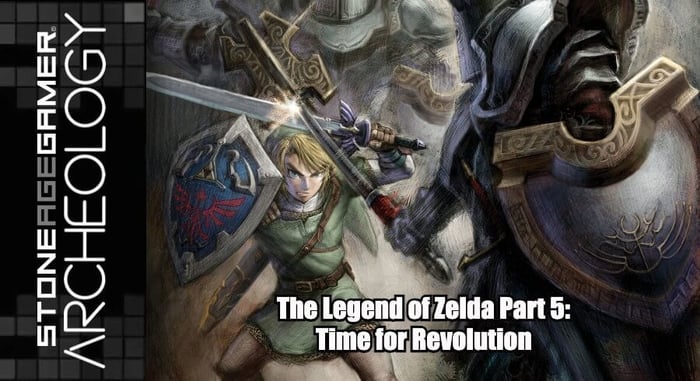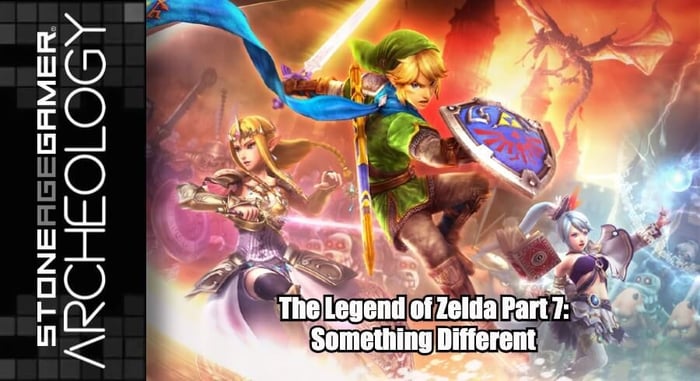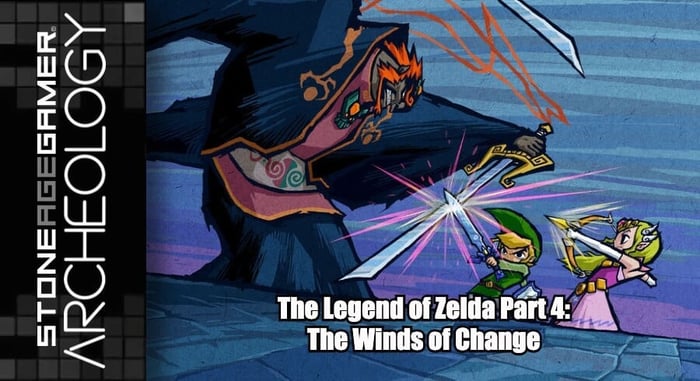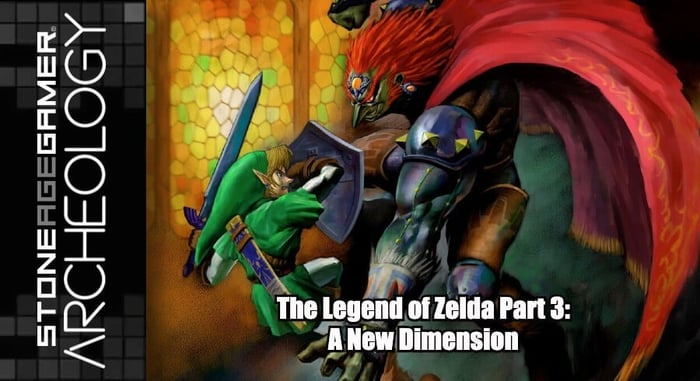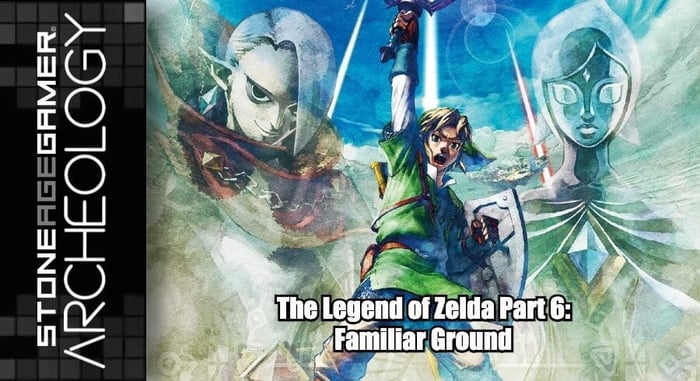
The Legend of Zelda Retrospective Part 6 - Familiar Ground
Welcome to Part 6 of our 8-part Zelda retrospective. In this episode, we look closer at Nintendo's experiments that ultimately lead to the series reinvention on Switch, as well as a trio of remasters, and the series complicated timeline.
In this series, we aim to tell the story of the Zelda series as it unfolded for North American audiences. We are not only looking at the games themselves, but the historical context surrounding them, and what it was like being a fan as these games were being released.
Watch more Stone Age Gamer Archeology: https://youtube.com/playlist?list=PLoWJAVdwC7Z_CC...
Transcript of the video:
Just as Nintendo had hoped, the Wii was in fact, a revolution. The motion controller and Wii Sports skyrocketed the platform to a level of home console success Nintendo hadn’t seen in ages, and even their illustrious competition wanted to get in on the action with their own attempts at motion controlled gaming. As predicted, the video game landscape had once again changed, but The Legend of Zelda, had not, a problem that Nintendo was keenly aware of.
With every release since Ocarina of Time, a common sentiment had been slowly growing. The Zelda formula was in danger of growing stale. While the games were consistently well received, it was becoming clear that they had taken the Ocarina formula as far as it could go. Zelda needed to evolve into something that felt like a modern game, while also maintaining what fans loved about the series in the first place. It was time for some experiments.
At E3 2011, Nintendo officially unveiled their next generation home console, the Wii U. In order to display the system’s capabilities, Nintendo put together a tech demo based on The Legend of Zelda called The Zelda HD Experience. Featuring a visual style that seemed like a cross between Ocarina of Time and Twilight Princess, this interactive video sequence didn’t allow players to control the action directly, but instead, the environment around it. Link enters a temple and is ambushed by an enormous spider creature. During the action, players could press various virtual buttons on the Wii U Gamepad to change the game’s lighting from night to day, and seamlessly switch the action from the television to the Gamepad. It was an impressive demo, and though Nintendo was very clear about it not being footage from an actual game in development, it still got people's attention, and showed off the promise of what a Zelda game on Wii U could look like.
But Zelda for Wii U was still a very long way off, and Nintendo had some pressing concerns to attend to elsewhere.
Their latest handheld, the Nintendo 3DS, had gotten off to a rocky start. As a followup to one of their most successful platforms, the Nintendo DS, it seemed like the 3DS would be a sure thing, but fans weren’t buying it. Its launch library was less than inspiring, and many felt the price tag was far too high for a handheld device. The system’s use of glasses-free 3D was impressive, but that alone wasn’t enough. Three months after its release, Nintendo finally gave the platform its first killer app, by revisiting an old favorite.
The Legend of Zelda: Ocarina of Time 3D released in June 2011, and was more than a simple port. While not a completely comprehensive remake, Ocarina of Time 3D managed to give the Nintendo 64 classic a complete visual overhaul while staying remarkably close to the source material. Environments that used to be composed of static images were now rendered in full 3D. Character models were replaced with considerably more detailed ones. Environments featured much higher resolution textures, and animation was smoother than ever before. The sound, however, was untouched, meaning that all the Nintendo 64 music and effects remained intact. There were no structural changes to the main quest, but some subtle adjustments can be seen throughout, especially in the often maligned water temple, where visual indicators were added to help with managing water levels, and the iron boots were changed to an equipable item that could be taken on and off with the press of a button.
Unsurprisingly, Ocarina of Time 3D was a welcome addition to the 3DS library, and while many thought it didn’t go far enough in remaking the original, what it did do was still impressive. It wasn’t enough to turn the 3DS’s fortunes around, a feat that would eventually be accomplished by the release of key Mario titles and a massive price cut, but it was a start, and remains arguably the best iteration of the game to date.
But that wasn’t the only Zelda remake handheld players would get that year, and a few months later, Nintendo delivered an unexpected surprise.
The Legend of Zelda: Four Swords Anniversary Edition released in September 2011 as a free download for both the DSi and Nintendo 3DS to celebrate the 25th anniversary of the Legend of Zelda series.
This was a full remaster of the original Four Swords for Game Boy Advance, and included a number of enhancements. First and foremost, was a single player option. While multiplayer was still the way the game was intended to be played, the option to go through the adventure solo was a welcome one. Taking a cue from Four Swords Adventures, a single player could control two Links at once and swap back and forth to solve puzzles. It wasn’t a perfect way to play, but it did allow those who didn’t have the ability to coordinate with multiple other people to see what the game had to offer.
In addition, it also features a slight audio and visual makeover, wireless local multiplayer, and a set of new stages called Realm of Memories. These areas were based directly on Link’s Awakening for Game Boy, A Link to the Past for Super NES, and the original Legend of Zelda for NES, and cleverly mashed up their visual styles to great effect.
Four Swords Anniversary Edition was the first digital-only Zelda release, and while it was offered for free again in 2014, it’s currently unavailable in any form.
2011 had already been a very busy year for Zelda fans, but there was still something missing, the Zelda game for the Wii that Nintendo announced way back in 2009. Following some lengthy delays and a public showing at E3 riddled with technical issues, the highly anticipated game was finally complete, and Nintendo capped off Zelda’s 25th Anniversary celebration by releasing one of their most ambitious adventures yet.
The Legend of Zelda: Skyward Sword released in November 2011 for the Wii with the aim of being the ultimate in motion controlled adventure gaming. In fact many of Nintendo’s most high profile Wii releases to this point were in some ways testing grounds for Skyward Sword, specifically the massively successful followup to Wii Sports, Wii Sports Resort. Sword Fighting, archery, and even bowling were incorporated into the game in an effort to deliver the most immersive Zelda experience possible. And when it worked, it worked extremely well.
As the name suggests, Skyward Sword’s primary mechanics center around Link’s sword. Most enemies in the game required that they be hit from specific angles in order to do damage, meaning that the player would have to swing their Wii Remote in that direction to defeat them. This was a remarkably engaging form of combat, though it could become quite tedious as the game went on thanks to it often requiring patience on the player’s part, waiting for the right opportunity to strike. But the sword wasn’t just there for combat, it was also at the center of the game’s story, which takes place at the earliest point in the series timeline.
A long time ago, people lived in the sky on a collection of floating islands, with little to no knowledge of the land down below thanks to a thick, magical cloud barrier. On one of these islands there was a town called Skyloft, which was home to a knight’s academy. A student named Link was set to graduate to full knighthood at the upcoming Wing Ceremony, which would be performed by his childhood friend Zelda. After overcoming some trials against a local bully named Groose, Zelda finally bestowed Link with a ceremonial Sailcloth, and the two of them celebrated by taking a ride around the island on their Loftwings, giant birds who share a mystical connection to the citizens of Skyloft.
While in flight, a mysterious storm suddenly opened up and pulled Zelda in, knocking Link out in the process. He awoke back in Skyloft safely, but Zelda was nowhere to be found. After speaking to the headmaster, Link encountered a mysterious spirit who led him back to the Goddess Statue used in the Wing Ceremony. Once there, she opened up a secret chamber underneath the statue where a sword waited in a pedestal. This was the Goddess Sword, and the mysterious figure that led Link there was the sword’s spirit, Fi. She assured Link that Zelda was in fact still alive, and on a very important path of her own. To fulfill his part in these events, he would need to take up the sword, and search for her beneath the clouds.
The adventure that followed aimed to combine elements from Link’s previous adventures to create the ultimate expression of what Nintendo had established in Ocarina of Time. The visual style was a cross between Twilight Pricess’s realistic proportions and The Wind Waker’s animated approach. The result was a striking, almost watercolor look that was well suited to the Wii’s graphical limitations. Like the Great Sea in The Wind Waker, The Sky was a massive expanse full of islands to visit, while the land below was teeming with unusual life and large open locales like in Twilight Princess. The dungeons themselves were some of the most clever in the series, complete with some incredibly memorable bosses, including recurring battles with a villain named Ghirahim. He was the one responsible for the storm that took Zelda, but before he could capture her, she was saved by a Servant of the Goddess named Impa. Ghirahim’s goal was to capture Zelda and use her spirit to resurrect his master, the Demon King Demise. Link, with the help of Fi, must set out to find Zelda, and stop Ghirahim at any cost.
The story of Skyward Sword was a much more personal one than nearly any entry in the series thus far. Zelda was not a princess, but a childhood friend of Link’s, and the two clearly had strong feelings for one another. Fi, Groose, Impa, and Ghirahim all proved to be well rounded and interesting characters in their own ways, and combined with the striking visual style and gorgeous musical score brought a level of emotion to the game that surprised and delighted fans.
However, some rather significant issues managed to plague the experience. The sky’s islands were plentiful, but most of them served no purpose, and contained no items or characters to talk to. The motion controls didn’t work in certain environments, rendering the game nearly unplayable for some. A repeating boss battle with a strange looking monster called The Imprisoned frequently brought the game’s pace screeching to a halt. And while the world of the surface beneath the clouds was interesting, each one had to be repeated in a slightly altered form before the end of the game. These issues lead to Skyward Sword’s mixed reception with most media outlets praising the game, but many fans expressing disappointment.
Still, it provided players with some of the series most fascinating lore, including the origins of The Master Sword, and the eternal connection between Link, Zelda, and Gannondorf, the eventual reincarnation and physical embodiment of the hatred within The Demon King Demise.
While not immediately obvious at the time, Skyward Sword’s legacy within the Legend of Zelda is a significant one. It secretly served as the first test in figuring out how to properly reinvent the series, and introduced several important mechanics that would become integral to future installments. It wasn’t perfect, but it quickly became a fan favorite thanks in large part to its emotional storyline, memorable characters, and excellent soundtrack. It was not, however, the success Nintendo had hoped, with sales falling well below expectations.
Still, the experiment was ultimately a success in that it provided Nintendo with the information they were looking for. Work on the next Zelda game began immediately after the release of Skyward Sword, but there were still more experiments to be done. And while they worked on their next test, they gave fans something they never thought they’d get. Clarity.
The stories of each Zelda game were typically explained quite well, but one thing had consistently remained a mystery. How, or if, any of these stories fit together. Many fan theories existed and were discussed in online forums and school playgrounds for years, but Nintendo rarely commented on the existence of an official timeline. That all changed in January 2013 when Nintendo and Dark Horse Publishing released a book called The Legend of Zelda: Hyrule Historia. This massive hardcover was an all-encompassing history of every official story in the Legend of Zelda series. Artwork, history, character profiles, and interviews filled its pages with more information than longtime fans ever thought they’d get from an official source. Above all else, the book contained Nintendo’s official timeline for the Zelda series, or rather, timelines.
According to Hyrule Historia, the stories told in The Legend of Zelda connect through not one, but three separate timelines. These include the stories found in the games themselves, as well as events that have yet to be depicted. They all start with Skyward Sword as the earliest in the series, followed by The Minish Cap, Four Swords, and Ocarina of Time, which is where the timeline splits in two. One path follows what happens when Link succeeds in defeating Ganon, and the other if he fails. Link’s defeat in Ocarina of Time leads to The Imprisoning War described in the Link to the Past instruction manual, which naturally then leads to A Link to the Past itself. That’s followed up by Oracle of Ages and Oracle of Seasons, Link’s Awakening, The tragedy of Princess Zelda the 1st as depicted in the Zelda II instruction manual, The Legend of Zelda, and Zelda II: The Adventure of Link.
The Hero is Triumphant timeline is itself then further split into two of its own timelines, one that follows Link as a child once he is returned to his own time after defeating Ganon, and the one where Adult Link no longer exists since he was sent back to the past. The child timeline starts with Majora’s Mask, followed by the execution of Gannondorf by the royal family. Next comes Twilight Princess, followed by Four Swords Adventures.
The final timeline where the Link from Ocarina of Time no longer exists begins with the events shown in the intro of The Wind Waker, followed naturally by The Wind Waker itself, Phantom Hourglass, and Spirit Tracks. All other releases and stories were not considered official canon.
This information was both fascinating and confusing for fans. Many felt that the split timeline following Ocarina of Time made sense, but an entirely different timeline based on Link’s failure at the end of Ocarina felt contradictory. However, the timeline came with a disclaimer.
“This chronicle merely collects information that is believed to be true at this time, and there are many obscured and unanswered secrets that still lie within the tale. As the stories and storytellers of Hyrule change, so, too, does its history. Hyrule’s history is a continuously woven tapestry of events. Changes that seem inconsequential, disregarded without even a shrug, could evolve at some point to hatch new legends and, perhaps, change this tapestry of history itself.”
With this paragraph, Nintendo effectively gave themselves a free pass from scrutiny. While The Legend of Zelda timeline was a fascinating topic, it was not something to be taken too seriously as it could change completely at a moment's notice. Still, the book was a massive success, and was eventually followed up by two complimentary releases in the coming years, The Legend of Zelda: Art & Artifacts and The Legend of Zelda: Encyclopedia.
What wasn’t performing so well was the Wii U. Following a lackluster launch, the system continuously struggled to find an audience. However, in their January 2013 Nintendo Direct presentation, series producer Eiji Aunoma laid out the basics of Nintendo’s plans for Zelda on Wii U. According to Aunoma, the mission was to “Rethink the conventions of Zelda.” Here he confirmed to audiences that Skyward Sword was in fact something of an experiment in service of this new mission statement, and that the franchise’s linearity was also something they were looking closely at changing.
He then mentioned the Zelda HD Experience they showed off at E3 2011, which in fact was used as part of the new Zelda game’s development in that it was a test for art direction. Following that presentation, they continued experimenting with converting previous Zelda styles into HD to find a look that suited their next adventure, but when they came to the Wind Waker, the results were particularly impressive. So since this new reinvention of Zelda was still a long way off, they decided to dedicate a portion of their resources to bringing the now decade old classic in full to a whole new audience.
The Legend of Zelda: The Wind Waker HD released in October 2013, bringing what was widely regarded as one of the series most beautiful releases to high definition for the very first time. And unlike its initial controversial release on GameCube 10 years prior, was welcomed by fans with open arms.
Applying a number of lighting changes and high resolution textures brought The Wind Waker’s world to life like never before, and while it arguably lost some of the visual charm that made the original stand out, what it offered in its place was equally attractive, just in a slightly different way.
The bulk of the game remained unchanged, but feedback from its initial release was taken into account. A new item called the Swift Sail could be obtained that allowed Link to travel the sea without having to manually change the direction of the wind. Inventory management and the sea chart were moved to the Gamepad screen for ease of use, and the dreaded Triforce quest that led to the game’s finale was significantly streamlined.
Given the Wii U’s relatively small user base, sales for The Wind Waker HD were unsurprisingly low, but those who did purchase the game were treated to a modern iteration of a fan favorite without all the negative stigma that surrounded the original version’s GameCube release. Revisiting old worlds was a great way to keep fans happy while they waited for news on whatever Nintendo’s big series reinvention was going to be. So much so that one month later, they did it again, but in a very different way.
The Legend of Zelda: A Link Between Worlds released in November 2013, and takes place in the same world as A Link to the Past. Set an undisclosed number of years following the events of the Super NES classic, a young blacksmith’s apprentice named Link sets out to deliver a sword to Hyrule Castle. While searching the nearby Sanctuary for the soldier who the sword belongs to, Link witnesses a sorcerer named Yuga transforming the Priest’s daughter Seres into a painting. Link tries to stop Yuga, but was quickly tossed aside. He wakes up back at his house where he is surprised to find a traveling merchant named Ravio next to him. He tells Link he must inform Princess Zelda of Yuga’s attack, but also awkwardly asks if he could be allowed to stay in his house while he’s out adventuring. In return for a place to stay, he gives Link a magical bracelet. Once at Hyrule Castle, Zelda gives Link the Pendant of Courage for safe keeping, and sends him to find the Kakariko Village elder, who then sends him to find a student of his named Osfala to warn him that Yuga might be coming for him next since like Seres, he is also a descendant of the Seven Sages of The Imprisoning War. Sure enough, Yuga tracks Osfala down and turns him into a painting as well. Link faces Yuga once more, but in the process is himself turned into a painting. Thankfully, Ravio’s bracelet was able to not only free Link from the curse, but allowed him to transform back and forth at will.
Yuga’s next step was to cast a barrier around Hyrule Castle, trapping Zelda inside. Link then needed to find the remaining two pendants so he could lift the Master Sword, destroy Yuga’s barrier, and rescue the Princess, but just like in A Link to the Past, this was only the beginning.
During his confrontation, Yuga managed to escape through a crack in the wall. Link followed and emerged on the other side in a familiar-looking locale. It looked like the Dark World from A Link to the Past, but was in fact a parallel dimension called Lorule. Yuga’s plan was to use his newfound paintings to revive Ganon. Once summoned, he merged with the beast in a bid to control the Triforce of Power. Yuga then turned to Link, but was stopped by Lorule’s princess Hilda who transported Link to safety, told him to find the paintings, free their prisoners, and utilize their power to stop Yuga.
Though the overworld maps for both Hyrule and Lorule were effectively the same as their 16-bit counterparts, the dungeons were completely redesigned to include a new focus on verticality, a feature that used the 3DS’s screen to great effect. But the biggest difference actually came in the game’s structure. Thanks to Ravio having set up an item rental shop in Link’s house, dungeons could be tackled in whatever order the player chose. This nonlinear style broke with series tradition and lent a newfound sense of freedom to this familiar world.
In the end, Princess Hilda turned out to be the true force behind Yuga in an attempt to steal Hyrule’s Triforce to bring prosperity back to Lorule. This plan backfired when Yuga betrayed her, but thanks to a surprising display of courage from Ravio, whose secret identity was finally revealed, Hilda was convinced that what she was doing was wrong, and helped return Link, Zelda, and the Triforce to their own world.
A Link Between Worlds was well liked by both fans and critics. It was criticized for its overly simplistic art direction, but the clever puzzle designs, interesting story, memorable new characters, and fantastic musical score more than made up for it, and ultimately proved to be a worthy successor to one of the series most celebrated entries.
Both Skyward Sword and A Link Between Worlds stood as unique games on their own, but they each featured changes to the Zelda formula that would become the cornerstones of Nintendo’s new concept for the franchise.
Skyward Sword tested more realistic physical limitations set against an ability to traverse massive landscapes via the sky, while A Link Between Worlds tested a new non-linear format in a familiar setting. The lessons learned from these two games would be applied directly to Zelda for Wii U, which had quickly become a massive undertaking, and one of Nintendo’s most ambitious projects in the company’s history. But with the Wii U console itself failing to reach mainstream success, Nintendo was faced with a daunting task. Bringing their new Zelda concept to the world was going to require radical change. Change that wouldn’t come to fruition for another four years.
Join us next time as Nintendo keeps fans busy by applying a whole new genre to the Zelda formula, while also revisiting old ideas, and familiar faces.


